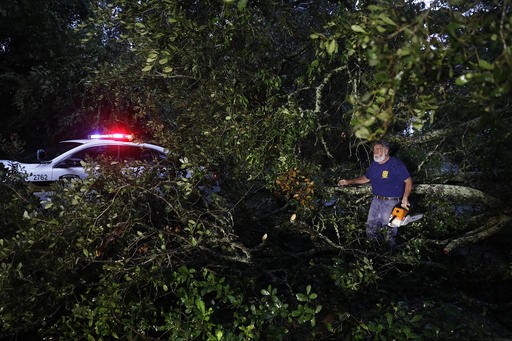Weakening but still powerful Matthew rakes Atlantic coast
Change Size
 Andy Jones clears away limbs from a tree blocking a road after it fell over from Hurricane Matthew on St. Simons Island, Georgia, Oct. 8, 2016. Matthew plowed north along the Atlantic coast, flooding towns and gouging out roads in its path. (AP/David Goldman)
Andy Jones clears away limbs from a tree blocking a road after it fell over from Hurricane Matthew on St. Simons Island, Georgia, Oct. 8, 2016. Matthew plowed north along the Atlantic coast, flooding towns and gouging out roads in its path. (AP/David Goldman)
A
weakening Hurricane Matthew continued its march along the Atlantic coast Saturday, lashing two of the South's most historic cities and some of its most popular resort islands, flattening trees, swamping streets and knocking out power to hundreds of thousands.
The storm was blamed for at least four deaths in the US, all in Florida. In its long wake, it also left well over 300 people dead in Haiti.
On Saturday, Matthew raked the Georgia and South Carolina coasts with torrential rain and stiff winds. But just as it did during its long trek up the Florida shoreline, its center, or eye, mercifully stayed just far enough offshore that coastal communities didn't feel the full force of its winds.
At 8 a.m., Matthew was centered about 20 miles southeast of Charleston, its winds having dropped to 85 mph, a Category 1 storm. That was down from 145 mph when the storm roared into Haiti.
Matthew brought some of the highest tides on record along the South Carolina coast. Streets and intersections in historic Charleston — a city of handsome pre-Civil War homes and church steeples — were flooded.
At least one gust of 87 mph was recorded at the golf-and-tennis resort island of Hilton Head, South Carolina.
The storm also lashed Savannah, Georgia, another historic town of moss-draped squares and antebellum mansions, and scraped Georgia's Tybee and St. Simons islands.
More than 150,000 electric customers in South Carolina were without power, and 250,000 were in the dark in coastal Georgia. Matthew was expected to near North Carolina's southern coast by Saturday night.
"Now is the time we ask for prayer," Gov. Nikki Haley said, bowing her head.
Matthew — the most powerful hurricane to threaten the Atlantic Seaboard in more than a decade — set off alarms as it closed in on the US.
But in the end, it skirted Florida's heavily populated Miami-Fort Lauderdale-West Palm Beach area, and sideswiped the cities farther north, including Daytona Beach, Vero Beach, Cape Canaveral and Jacksonville, without its center ever actually coming ashore.
Well south of the storm, things quickly began returning to normal, with all three of Orlando's main theme parks — Walt Disney World, Universal Studios and SeaWorld — reopening Saturday morning.
In Georgia, Steve Todd defied orders to evacuate Tybee Island even after the mayor called and pleaded with him to leave. As conditions rapidly deteriorated Friday night, Todd wasn't sounding quite so bold.
"I'm not regretting staying," Todd said by telephone. "But I'm not going to lie: There's a little bit of nervous tension right now."
Todd said he was staying with friends at a third-story condo, which had lost electricity.
"It's throwing down right now," Todd said. "The trees are bending over. We saw a bush fly by. It's raining sideways now."
In Florida, the storm gouged out several large sections of the coastal A1A highway north of Daytona Beach.
"It's pretty bad; it's jagged all over the place," said Oliver Shields, whose two-story house is within sight of the highway.
The deaths in Florida included an elderly St. Lucie County couple who died from carbon monoxide fumes while running a generator in their garage and two women who were killed when trees fell on a home and a camper.
About 500,000 people were under evacuation orders in the Jacksonville area, along with another half-million on the Georgia coast. More than 300,000 fled their homes in South Carolina.
On Friday, the storm raked yet another historic Southern city: St. Augustine, Florida, which was founded by the Spanish in the 1500s and includes a 17th-century stone fortress and many historic homes turned into bed-and-breakfasts. The city left awash in rain and gray seawater.
Associated Press writers Holbrook Mohr in Orlando, Florida; Gary Fineout in Tallahassee, Florida; Kelli Kennedy and Terry Spencer in Fort Lauderdale, Florida; Jennifer Kay, Freida Frisaro and Curt Anderson in Miami; Marcia Dunn in Cape Canaveral, Florida; Janelle Cogan in Orlando, Florida; Russ Bynum in Savannah, Georgia; Martha Waggoner in Raleigh, North Carolina; Jeffrey Collins on Hilton Head Island, South Carolina; Jack Jones and Meg Kinnard in Columbia, South Carolina; and Bruce Smith in Charleston, South Carolina, contributed to this report.









